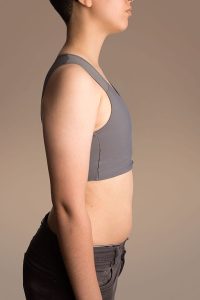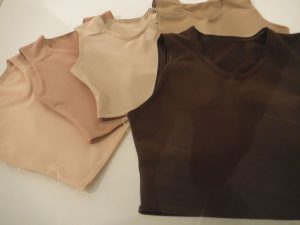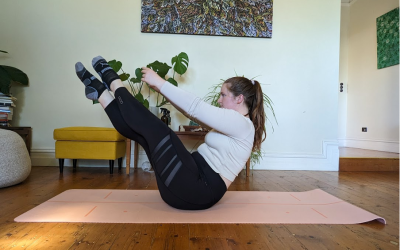Chest binding. A simple guide to safe chest binding.
By Indigo Bunbury-Smith
Here and queer? Great! You’re in the right place to learn more about your options when it comes to chest binding. From commercial binders to more homemade solutions there are many options available. When binding your chest, it is important to know the potential risks, how to mitigate reduce them and how to look after yourself while binding.
Read on to learn more about safe chest binding.
Why do people bind?
Chest binding is the practise of applying compression to flatten and reduce the appearance of breast tissue of the chest. It is often used as a gender affirming practice and may be thought of in relation to gender identity and the transmasculine community. However it can be used by anyone wishing to compress their chest for comfort or appearance.
What options do I have when it comes to binding?
Purpose built binders
The most ideal option is a commercial binder. This type of chest binder is purpose made with your comfort and safety in mind. They can be hard to get your hands on and if you can find them, you have the challenge of working out which size fits you best.
Luckily for you, if you’re interested in buying or trying on a binder, we have a small range available at our clinic to help you decide what style and fit might be best for you. Sadly, we don’t sell them, however we offer a safe space to explore your options and make your decision a little easier!
If you’re considering chest binding, have a look at our quick guide for some comparisons on different binders you can buy.
Quick binder provider guide
| Brand | Binders + price | Site | Notes |
| Sock drawer (underworks) |
|
https://sockdrawerheroes.com/collections/binders | Have a pay it forward program. Aus brand, Sydney based. |
| Amor (our Favourite!) |
|
https://www.andyamor.com | NDIS + pay it forward. Melb brand. Sustainable. Sensory friendly, reversible racerback XXS-6XL |
| GC2B |
|
https://www.gc2b.co/collections/gc2b-all-nude | International. Some nude styles. XXS-5XL |
| Spectrum outfitters |
|
https://spectrumoutfitters.co.uk/collections/spring-collection | Great info resource. UK brand. XXS-7XL Low stock. |
Www.theshedsupport.org.au/binders
- Binder exchange program if cost is a factor
www.resilienceenterprises.com.au – links to trans underwear, swimwear, binders (sellers on etsy) ** note sports binders recommended to have a size up – possibly good idea if person is still growing to have another available in a larger size
Other alternatives
If you’re not considering a purpose build binder, there are a couple of different options you can use to help minimise chest tissue.
Sports bras – sports bras are an incredibly accessible option. They’re often made of lyrca which increases their breathability and reduces their risk of skin irritation. Sports bras provide great compression and reduction of movement. Shop around to find something that fits you comfortably (in the right size) and that doesn’t restrict your breathing.
Layering loose clothing – even easier than a sports bra, layering your clothes is a great option if you’re just starting with chest binding. A good foundation is a sports bra followed by a couple of shirts. Make sure each shirt is bigger than the last and you’re good to go!
Athletic compression shirts – the name say it all! The shirts are made of compressive material that has good breathability and airflow properties. They can also be layered with a sports bra. Make sure you choose a compression shirt that fits you correctly and that you can easily breathe in.
Neoprene shirts or waist trainers – more commonly known as wetsuit material, neoprene can provide some decent compression. Sadly, whilst it’s great for chest binding it isn’t great for breathability. Some people use baby powder or wear a light shirt underneath to help reduce sweat and skin irritation. Make sure you select a style that fits you well and allows you to breathe properly.
Remember if you start feeling chest pain or shortness of breath, you should take off the binder as soon as possible and let your body rest.
What is the health impact of chest binding?
There are certain risks to binding your chest that you need to be aware of. Symptoms can include:
• Skin irritation sores
• Sores
• Pain through your upper body
• Breathing difficulties including cough and shortness of breath
• Numbness
• Dizziness
• Changes to your posture or bone anatomy
• Muscle wasting
Roughly 89% of people who bind their chest have experienced some sort of binding related symptom. Therefore, it is incredibly important that you reduce your risk by following safe binding practices.
Whilst some of these symptoms may seem minor and easy to overcome, being informed and reducing your risk when chest binding is always the best option.
Binding dos and don’ts
And finally, let’s look at some easy do’s and don’ts when it comes to chest binding.
Binding do’s
● Bind for less than 8 hours per day – it is important to give your body a rest from the compression, so try to limit how long you wear your binder for
● Take at least 1 day off from binding every week – you can try and cater this around a day when you don’t plan on leaving home or when you can easily wear oversized clothing
● Wear binders that fit correctly – wearing smaller sizes of binders may increase your risk of adverse effects
● Keep an eye out for any of the above side effects and if you start to experience them you should take a break from binding
● Stay hydrated when wearing a binder – this will help reduce your risk of overheating, and is especially important in summer
Binding don’ts
• Sleep with a binder on
• Bind with duct tape or plastic wrap – these can cause significant health concerns and are not worth it, try some of the options listed above instead
• Wear a binder when exercising
Frequently asked questions
Do binders permanently flatten your chest?
Binding will flatten breast tissue on the chest. However, it will not shrink breast tissue or prevent it from growing. If done incorrectly, you can risk damaging muscles, chest tissue and other parts of the body. A sensible and safe approach is best when chest binding.
Do chest binders work on large chests?
Chest binders do work on larger chests; however, you may need to experiment with the type of binder you use and the application. Laying down can help as can adjusting the tissue. If you have a larger chest, it is important to ensure that you aren’t compromising your safety for a flatter look. Use a combination of methods if required to achieve an outcome you’re comfortable with.
Is chest binding safe?
When done properly and when you give your body the opportunity to rest, chest binding is safe. Make sure to select a chest binder that is comfortable for you and to consult with your healthcare professional, like your osteo, for support on how to support your body whilst chest binding.
Whether you choose a purpose made binder or not, these guidelines are a great base for safe chest binding.
If you’re struggling don’t be afraid to reach out to someone you trust, be it family, friends or a healthcare provider.







